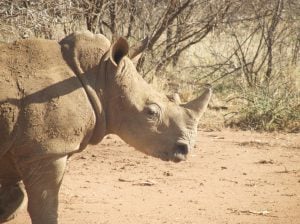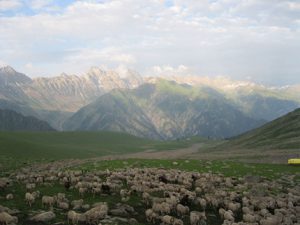Hongqiao Liu (HL): In Traffic’s report submitted to the CITES CoP16 meeting, you point out that, “in addition to Vietnam, China also appears to be emerging as a country of concern”. What are the concerns?
Tom Milliken (TM): China has the highest seizure rates of illegally traded wildlife in Asia. A large number of European export permits have also been issued recently to move auctioned rhino horns and antique libation cups to China, and a large number of live white rhino have been exported to China, apparently by a private company interested in the production of rhino horn medicines.
HL: In your last report, The South Africa – Vietnam Rhino Horn Trade Nexus in 2012, you also point out that the rhino horn trade in China is more active than previously recognised. How much do we know about the trade in China?
TM: There’s evidence of increased trade in China, but we have yet to put it into perspective. We are not sure yet what’s causing the increase and we don’t understand the scale.
HL: How are rhino horns traded in China?
TM: We believe that in certain provinces in China like Guangdong, Guangxi, Yunnan and maybe Fujian, there is considerable interest in rhino horn. Their culture might be similar to what we have seen in Vietnam, where rhino horn is not often used as medicine but rather a product that provides status for its owners. This is what’s driving the trade in Vietnam, and may be part of what’s driving the new trade in China.
HL: What roles do Chinese usually play in the supply chain?
TM: Chinese individuals have usually been what we consider as “middleman players” that connect Africa and Asia. Rhino horns poached from illegal hunting are usually handed over to an African middleman player who will then interface with Chinese buyers at the next level. The Chinese middleman players know how to get the horns to market in Asia. They also know the middlemen in the Asian market who will receive the horns from South Africa and sell them on to the next link.
HL: China has reported an 80% increase in seizures of illicit rhino trafficking in Asia in the last few years. Chinese authorities argue that this is indicative of strong law enforcement rather than a large scale illegal trade. Do you agree?
TM: It demonstrates good law enforcement by the Chinese authorities, but it also indicates there is more traffic in rhino horns these days. However, we have to take variables like governance, corruption and reporting rate into consideration whenever we look at law enforcement data.
HL: According to Interpol, seizure numbers usually only reflect 10% of the whole illicit trade. Can we calculate the scale of the illicit trade in China from the seizure numbers?
TM: It’s very difficult to use law enforcement data to produce absolute numbers or the percentage of China’s illicit trade. These statistics and seizure numbers are simply a clue that illegal trade is happening in China.
HL: Why are rhino horn antiques a problem in China?
TM: In Europe Chinese buyers are heavily involved in purchasing antique rhino horn balls and cups from the Ming Dynasty. Because of concerns that the horns and cups might be ground up for medicine, the European Union is changing its policy on the export of libation cups.
HL: There have been concerns about a Chinese company called Longhui Farm in Sanya City, Hainan province and its ongoing live rhino horn harvesting for years. Considering that China banned the rhino horn trade and its medical use, is this a sign of reviving the legal use of rhino horn medicines in China?
TM: Longhui is responsible for importing as many as 100 rhinos from South Africa. Until recently on their website they had a business plan to breed the rhinos, harvest the horns, and produce rhino horn medicines. The business plan was later taken off the website. We have been told it was under pressure from the Chinese government. I don’t believe the government is behind the import of the rhinos, but I do see concerns that businesses in China intend to profit from the rhino horn trade.
HL: What are the common routes of rhino horn trafficking to China?
TM: We have documented cross border trade between Vietnam and China. We also documented Chinese tourists purchasing rhino horns in Vietnam and bringing them back to China. Large rhino horns were also seized in containers in Hong Kong, which were allegedly meant for Guangdong province. We formerly believed there was a rhino horn trade between Fujian and Taiwan, but it was last documented in the early 1990s. India has reported that rhino horns from Assam have passed illegally to Nepal, to neighboring Tibet, and from there we don’t know what happened to them. There are also direct routes from Africa to China by air using Kenyan, Ethiopian and Qatari airlines. These trade routes are also being used to move ivory, and we believe on some occasions, rhino horns.
HL: You said in your earlier report in 2012 that there was only limited evidence to support the idea that rhino horns were being moved from Vietnam to China. Has that situation changed?
TM: Yes. At that time, only two seizures, adding up to three rhino horns, had been documented for the trade between Vietnam to China. Since 2013, China has made a series of seizures at the Vietnamese border. Traffic has also received information from Vietnam and Laos indicating that rhino horns imported by these countries are then re-exported to China. There is an ongoing investigation in Vietnam of a particular seller that sells only to Chinese visitors who buy all rhino horn products, including a new product, rhino horn bracelets. We also have evidence from Vietnam that some Chinese individuals participate in drinking parties that serve ground rhino horn in the wine.
This story was supported by the Oxpeckers Center for Investigative Environmental Journalists and the Wits China-Africa Reporting Project.







